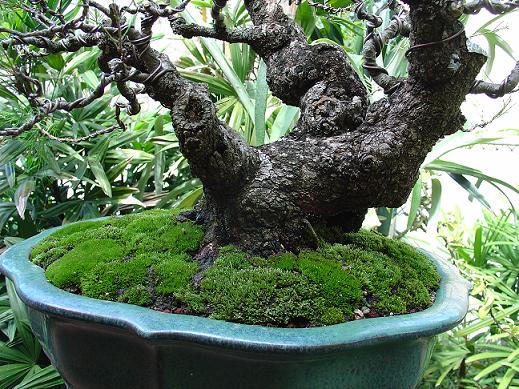Casuarina Equisetifolia (Cemara Udang or Mu Ma Huang)
+26
Khaimraj Seepersad
my nellie
ponsmaldo
Robert Steven
ogi uyehara
jonathan e
siriwatn
kcpoole
Peter Woosley
craigw
BonsaiAndino
allan
leonardo
Ka Pabling
gm.it.seacom
Ed Trout
Chris Cochrane
Rob Kempinski
ArtAtkinson
cosmos
priya uthama
hiram
Billy M. Rhodes
sentot
Garykk
jrodriguez
30 posters
Page 1 of 5
Page 1 of 5 • 1, 2, 3, 4, 5 
 Casuarina Equisetifolia (Cemara Udang or Mu Ma Huang)
Casuarina Equisetifolia (Cemara Udang or Mu Ma Huang)
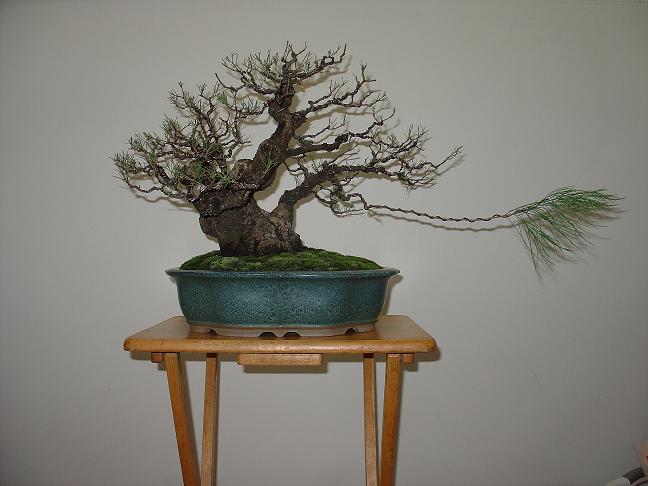
Casuarina Equisetifolia, Cemara Udang (Bahasa Indonesia) or Mu Ma Huang (Chinese) is a very good species for bonsai, particularly those that were collected in Madura, a small island in the Indonesian archipelago. In Spring these trees require lots of work and it is necessary to pinch and wire them almost every two weeks. This tree was collected many years ago. Prior to placing it in this pot, the tree was left alone to develop the basic structure. Although i am not yet satisfied with the branches, i think this bonsai will be very nice in a few years. Please Enjoy!!!
Last edited by jrodriguez on Mon Jun 08, 2009 2:05 pm; edited 3 times in total
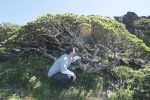
jrodriguez- Member
 Re: Casuarina Equisetifolia (Cemara Udang or Mu Ma Huang)
Re: Casuarina Equisetifolia (Cemara Udang or Mu Ma Huang)
Outstanding Casuarina. I would love to hunt these little jewels.
__gary
__gary
Garykk- Member
 Cemara udang madura
Cemara udang madura
Wow............. indah sekali P.Jose.
Thank for your share.
Salam
Sentot
Thank for your share.
Salam
Sentot
sentot- Member
 Re: Casuarina Equisetifolia (Cemara Udang or Mu Ma Huang)
Re: Casuarina Equisetifolia (Cemara Udang or Mu Ma Huang)
Gary,
Thanks for the comment. I believe there are several trees that you can collect in South Florida.
Sentot,
Indah Sekali!!! I wouldn't say it's exquisite, but thanks. Terimah Kasih!!!
Jose Luis
Thanks for the comment. I believe there are several trees that you can collect in South Florida.
Sentot,
Indah Sekali!!! I wouldn't say it's exquisite, but thanks. Terimah Kasih!!!
Jose Luis

jrodriguez- Member
 Re: Casuarina Equisetifolia (Cemara Udang or Mu Ma Huang)
Re: Casuarina Equisetifolia (Cemara Udang or Mu Ma Huang)
jrodriguez wrote:Gary,
Thanks for the comment. I believe there are several trees that you can collect in South Florida.
Yes BUT, they are considered "invasive" and on the banned list for nurseries.
Also, the variety common in Florida has very long needles/leaves.

Billy M. Rhodes- Member
 Re: Casuarina Equisetifolia (Cemara Udang or Mu Ma Huang)
Re: Casuarina Equisetifolia (Cemara Udang or Mu Ma Huang)
Mr. Rhodes,
I am aware that that casuarina, like melaleuca and Brazilian pepper is considered a pest tree in Florida. Although they cannot be sold in nurseries, I think the fact that they are considered an invasive tree is a green light to bonsai collectors. I know that the Florida State government is spending a lot of money to erradicate them, and i am sure that they won't mind if bonsai collectors help them a little.
Considering the needles, there are many types. In Florida, i have seen at least three varieties. Having worked with them for quite some time, i can tell you that those trees with reddish young growth do not have the ability to sprout multiple shoots when pinched back. Indonesian casuarina, however, has the ability to produce multiple buds whenever a branch is pinched. Contrary to widespread belief, Indonesian Casuarina does not weaken when it's constantly pinched. In fact, I have noticed that whenever the tree is left alone, all the branches tend to grow out, thus ruining the foliage structure.
Kind regards,
Jose Luis
I am aware that that casuarina, like melaleuca and Brazilian pepper is considered a pest tree in Florida. Although they cannot be sold in nurseries, I think the fact that they are considered an invasive tree is a green light to bonsai collectors. I know that the Florida State government is spending a lot of money to erradicate them, and i am sure that they won't mind if bonsai collectors help them a little.
Considering the needles, there are many types. In Florida, i have seen at least three varieties. Having worked with them for quite some time, i can tell you that those trees with reddish young growth do not have the ability to sprout multiple shoots when pinched back. Indonesian casuarina, however, has the ability to produce multiple buds whenever a branch is pinched. Contrary to widespread belief, Indonesian Casuarina does not weaken when it's constantly pinched. In fact, I have noticed that whenever the tree is left alone, all the branches tend to grow out, thus ruining the foliage structure.
Kind regards,
Jose Luis

jrodriguez- Member
 Re: Casuarina Equisetifolia (Cemara Udang or Mu Ma Huang)
Re: Casuarina Equisetifolia (Cemara Udang or Mu Ma Huang)
Hi, Jose. This is a very nice tree, i met you on the phone on saturday with your old teacher and my new one. next week we are thinking of collecting some of the ones we have here.
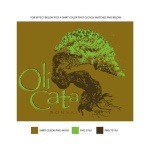
hiram- Member
 Re: Casuarina Equisetifolia (Cemara Udang or Mu Ma Huang)
Re: Casuarina Equisetifolia (Cemara Udang or Mu Ma Huang)
Hola Hiram!
Tienen que ir. Say hello to Carlos for me.
Cuídate,
jose
Tienen que ir. Say hello to Carlos for me.
Cuídate,
jose

jrodriguez- Member
 Casuarina equisetifolia
Casuarina equisetifolia
That is a really nice casuarina. It has an incredible bark texture making the tree look really old. In Malta I am trying to make the casuarina one of the top trees for bonsai. We find it very difficult to train our pines (Aleppo Pines) as bonsai. I think our only option is the casuarina because when trained well it resembles pines very much indeed. We are however new to this species and any information is more than welcome, viz. regarding the soil it likes best, pruning and grafting techniques and techniques for enlarging the nebari. Thanks and good day.
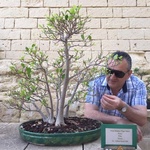
cosmos- Member
 Re: Casuarina Equisetifolia (Cemara Udang or Mu Ma Huang)
Re: Casuarina Equisetifolia (Cemara Udang or Mu Ma Huang)
Cosmos,
I was under the impression that aleppo was suitable for bonsai.
Jose
I was under the impression that aleppo was suitable for bonsai.
Jose

jrodriguez- Member
 Casuarina is a better option than Aleppo pine for bonsai
Casuarina is a better option than Aleppo pine for bonsai
Hi Jose,
Aleppo pine can be trained as a bonsai but we are finding it very difficult especially since it does not back bud and it keeps growing outwards and thus getting bigger. From our little experience (just 2 years), Casuarina seems a much better option and alternative. It has all the merits for a bonsai: back buds, responds well to pruning, hardy. But we still have uncertainties about it like those that I mentioned earlier plus the type of soil that you use for yamadori and for its cultivation. We are using a mixture based on natural soil, peat, corase gravel and lot of fine river sand.
Aleppo pine can be trained as a bonsai but we are finding it very difficult especially since it does not back bud and it keeps growing outwards and thus getting bigger. From our little experience (just 2 years), Casuarina seems a much better option and alternative. It has all the merits for a bonsai: back buds, responds well to pruning, hardy. But we still have uncertainties about it like those that I mentioned earlier plus the type of soil that you use for yamadori and for its cultivation. We are using a mixture based on natural soil, peat, corase gravel and lot of fine river sand.

cosmos- Member
 Re: Casuarina Equisetifolia (Cemara Udang or Mu Ma Huang)
Re: Casuarina Equisetifolia (Cemara Udang or Mu Ma Huang)
Hi folks - It's good to see a serious thread on Casuarina going. Here in Barbados we have a real problem with collecting them. or transplanting. I have 4 going at the moment but have lost a large number. We can collect anything up to 1/2 in. diameter trunks but bigger than that they send out shoots which die off in about 8 weeks. Bonsai people in the wider Caribbean also seem to have similar problem.
There are some questions that I have asked before but not got any answers.
1. When do you collect. Wet or rainy season? Active or dormant?
2. Potting mix? Here, most of the seedlings that spring up naturally do so in coral or lime based areas.
3. Do any of you collect your trees or buy them from collectors?
Art
There are some questions that I have asked before but not got any answers.
1. When do you collect. Wet or rainy season? Active or dormant?
2. Potting mix? Here, most of the seedlings that spring up naturally do so in coral or lime based areas.
3. Do any of you collect your trees or buy them from collectors?
Art
ArtAtkinson- Member
 Re: Casuarina Equisetifolia (Cemara Udang or Mu Ma Huang)
Re: Casuarina Equisetifolia (Cemara Udang or Mu Ma Huang)
Art & Cosmos,
Casuarina is a great tree for bonsai. Provided that the soil drains well and it retains enough moisture, the tree will do fine. I only use crushed volcanic cynder, mixed with a little crushed coral and a little humus. Although casuarina LOVES water, it HATES to have waterlogged soil.
In terms of establishing trees, casuarina buds are so small that they need proper shelter from the wind and sun. Also, perfect balance between watering and the amount of green growth should be established. I find it best to place the tree in its growth medium, water it well and cover the whole plant with a plastic bag. After this, the tree should be placed in a shady location until lush green growth can be seen through the plastic bag. Once this happens, proper precautions must be taken in order to acclimatize the new growth with the outside environment. It is best to poke a few holes on the bag or to wait for consequent reiny days and open the bag periodically.
I hope this information helps. This tecnique can be used to reestablish almost every tropical tree. It works particularly well with pemphis acidula.
Kind regards,
Jose Luis
Casuarina is a great tree for bonsai. Provided that the soil drains well and it retains enough moisture, the tree will do fine. I only use crushed volcanic cynder, mixed with a little crushed coral and a little humus. Although casuarina LOVES water, it HATES to have waterlogged soil.
In terms of establishing trees, casuarina buds are so small that they need proper shelter from the wind and sun. Also, perfect balance between watering and the amount of green growth should be established. I find it best to place the tree in its growth medium, water it well and cover the whole plant with a plastic bag. After this, the tree should be placed in a shady location until lush green growth can be seen through the plastic bag. Once this happens, proper precautions must be taken in order to acclimatize the new growth with the outside environment. It is best to poke a few holes on the bag or to wait for consequent reiny days and open the bag periodically.
I hope this information helps. This tecnique can be used to reestablish almost every tropical tree. It works particularly well with pemphis acidula.
Kind regards,
Jose Luis
Last edited by jrodriguez on Wed Jul 01, 2009 4:02 pm; edited 1 time in total

jrodriguez- Member
 Casuarina is a better option than Aleppo pine for bonsai
Casuarina is a better option than Aleppo pine for bonsai
Hi Jose,
Thanks for sharing information on Casuarina. I have been googling Casuarina for more than a year and some very nice trees can be found on http://sidiao.myweb.hinet.net/gallery_e.htm These trees are really fantastic. I have also come across some pictures that show how to enlarge the nebari but they are just pictures; there is no information on how exactly one goes about it. It seems that the Casuarina readily forms surface roots by placing some mosit peat around the base of the main trunk. Then these young roots are directed outwards and out of the bonsai pot into long tubes filled with compost mix. The tree is lightly watered so that these roots grow into the tubes to get water and enlarge in doing so. Subsequently the roots are severed and shortened to fit into the bonsai pot. Please note that all the above is just what I can conclude from the pictures since as I said I do not have any experience of this technique. If any one can enlighten us on the exact process we would be more than happy.
Thanks for sharing information on Casuarina. I have been googling Casuarina for more than a year and some very nice trees can be found on http://sidiao.myweb.hinet.net/gallery_e.htm These trees are really fantastic. I have also come across some pictures that show how to enlarge the nebari but they are just pictures; there is no information on how exactly one goes about it. It seems that the Casuarina readily forms surface roots by placing some mosit peat around the base of the main trunk. Then these young roots are directed outwards and out of the bonsai pot into long tubes filled with compost mix. The tree is lightly watered so that these roots grow into the tubes to get water and enlarge in doing so. Subsequently the roots are severed and shortened to fit into the bonsai pot. Please note that all the above is just what I can conclude from the pictures since as I said I do not have any experience of this technique. If any one can enlighten us on the exact process we would be more than happy.

cosmos- Member
 Re: Casuarina Equisetifolia (Cemara Udang or Mu Ma Huang)
Re: Casuarina Equisetifolia (Cemara Udang or Mu Ma Huang)
Cosmos
The site you mention belongs to my mentor and friend Cheng Cheng Kung. Those trees don't belong to him, but have been trained by members of the Taiwan Bonsai Creators.
The technique you mention was developed in Pluit, a suburb in Jakarta, Indonesia. I have several pictorials which will be posted later on.
Kind regards,
Jose Luis
The site you mention belongs to my mentor and friend Cheng Cheng Kung. Those trees don't belong to him, but have been trained by members of the Taiwan Bonsai Creators.
The technique you mention was developed in Pluit, a suburb in Jakarta, Indonesia. I have several pictorials which will be posted later on.
Kind regards,
Jose Luis

jrodriguez- Member
 Casuarina equisetifolia
Casuarina equisetifolia
Hi Jose,
As I said I have been googling for information on Casuarina for more than one year now. Those trees are awesome, and I am not only referring to the Casuarinas but even the other trees. I would be really a happy man if you send the pictorials of the technique to enlarge the nebari (plus any notes). Casuarina has really hooked me. I am addicted to it. Indeed, since yamadori is not possible on our small island in the middle of the Mediterranean, I have been growing them from seeds and from air-layerings. These are only humble beginings when compared to the Casuarinas in Taiwain. Are those Causarinas all yamadori?
Regards
Cosmos
As I said I have been googling for information on Casuarina for more than one year now. Those trees are awesome, and I am not only referring to the Casuarinas but even the other trees. I would be really a happy man if you send the pictorials of the technique to enlarge the nebari (plus any notes). Casuarina has really hooked me. I am addicted to it. Indeed, since yamadori is not possible on our small island in the middle of the Mediterranean, I have been growing them from seeds and from air-layerings. These are only humble beginings when compared to the Casuarinas in Taiwain. Are those Causarinas all yamadori?
Regards
Cosmos

cosmos- Member
 Casuarina equisetifolia
Casuarina equisetifolia
You mean to tell me that not even one of those trees is a yamadori! Incredible. If they have been grown from seeds than that means that I should not dishearten myself: my humble beginings from seeds might pay some day!

cosmos- Member
 Casuarina equisetifolia
Casuarina equisetifolia
On scrutinizing the pictures I can see that you have been training the tree by the cut and grow method and that you leave only small tufts of 'leaves' on each growing point. Do you grow all Casuarinas this way and when is the best time to cut?
Best Regards
Cosmos
Best Regards
Cosmos

cosmos- Member
 Re: Casuarina Equisetifolia (Cemara Udang or Mu Ma Huang)
Re: Casuarina Equisetifolia (Cemara Udang or Mu Ma Huang)
There are collected Casuarina in Florida. I have one that I showed at the US 2008 National Exhibition. See page 87 of the US Exhibition Album. There are several varieties of Casuarina. The one that makes the sucker shoots, Casuarina lepidophloia, is very hard to collect successfully. Casuarina equistifolia seems suitable for collection. They need to be collected in the early summer so that they can recover in the warm weather.
This is a photo from two years ago. A better photo is also in my tome, ITB.
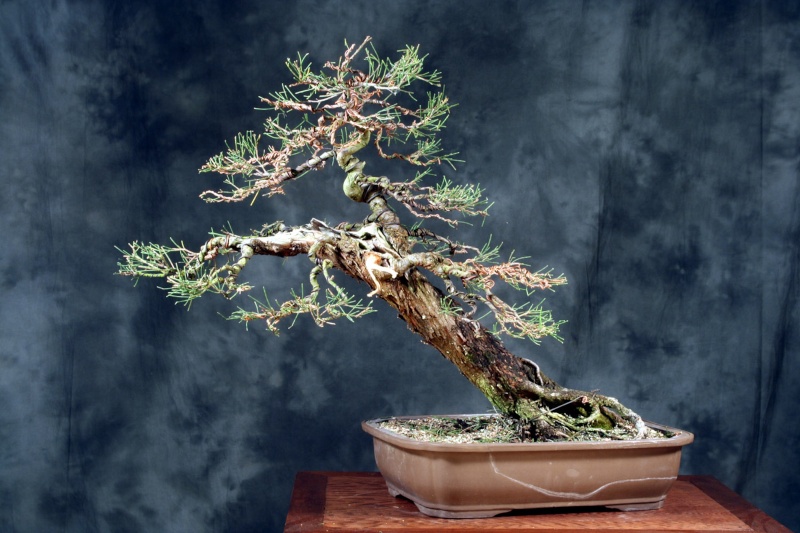
This is a photo from two years ago. A better photo is also in my tome, ITB.

Last edited by Rob Kempinski on Wed Jul 01, 2009 3:39 pm; edited 1 time in total (Reason for editing : added photo)

Rob Kempinski- Member
 Re: Casuarina Equisetifolia (Cemara Udang or Mu Ma Huang)
Re: Casuarina Equisetifolia (Cemara Udang or Mu Ma Huang)
Art,ArtAtkinson wrote:Hi folks - It's good to see a serious thread on Casuarina going. Here in Barbados we have a real problem with collecting them. or transplanting. I have 4 going at the moment but have lost a large number. We can collect anything up to 1/2 in. diameter trunks but bigger than that they send out shoots which die off in about 8 weeks. Bonsai people in the wider Caribbean also seem to have similar problem.
There are some questions that I have asked before but not got any answers.
1. When do you collect. Wet or rainy season? Active or dormant?
2. Potting mix? Here, most of the seedlings that spring up naturally do so in coral or lime based areas.
3. Do any of you collect your trees or buy them from collectors?
Art
Try air layering a nice section of trunk.

Rob Kempinski- Member
Page 1 of 5 • 1, 2, 3, 4, 5 
 Similar topics
Similar topics» Casuarina equisetifolia
» Casuarina equisetifolia
» Casuarina equisetifolia
» Large Casuarina equisetifolia
» Casuarina equisetifolia Development
» Casuarina equisetifolia
» Casuarina equisetifolia
» Large Casuarina equisetifolia
» Casuarina equisetifolia Development
Page 1 of 5
Permissions in this forum:
You cannot reply to topics in this forum







